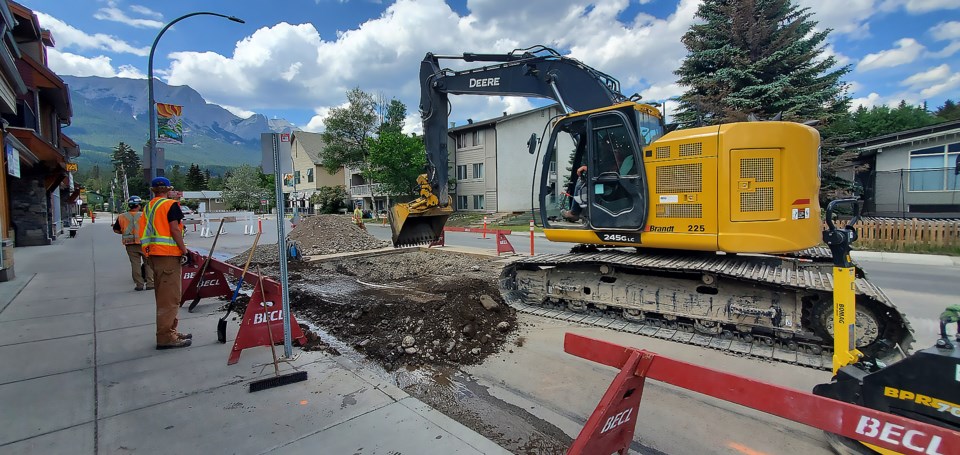A master plan outlining future Canmore infrastructure needs and the basis for ongoing off-site levy negotiations was accepted for planning purposes.
The Utility Master Plan (UMP), which was first presented at the May committee of the whole meeting, returned to council to receive a measure of council ascent.
“I’m happy we’re bringing this back. It’s certainly not something everybody does or that we absolutely have to do, but at least then there’s a level of awareness on council for it,” said Mayor Sean Krausert.
Krausert noted that he asked when other municipalities in the Alberta Mid-Sized Cities Mayors’ Caucus, that councils - were divided on whether to have municipal staff return for council approval or acceptance of similar infrastructure-related guiding documents.
He said there’s a range of perspectives, but added projects identified in the UMP would return as part of the budget process and approval of off-site levies, which are expected to return to Canmore council before the end of the year.
Coun. Tanya Foubert added she was “thankful this has come back for us to accept in order to provide council direction. I think that’s really important when it comes to the roles and responsibilities that we have as elected officials.”
The vital document is a key information piece that has identified $66 million in water treatment infrastructure, with the Town on the hook for a potential $40.5 million, developers contributing a projected $23 million and Dead Man’s Flats $2.5 million.
For sewer-related projects, a total of $28.1 million in 11 projects up to 2041 are estimated to have the Town pick up $22.8 million of the costs, developers $4 million and Dead Man’s Flats $1.28 million.
The most significant infrastructure cost identified at the May committee presentation, however, is necessary improvements to meet provincial environmental regulations by 2032 for the wastewater treatment plant to the tune of an estimated $75 to $125 million.
The UMP version accepted by council was the one presented at the May committee of the whole. Andreas Comeau, the Town’s manager of public works, noted they had made slight changes, specifically how deep utilities are to be cost shared based on the age of the pipe, leading to a further June 13 final version.
He added that with the Court of Appeal giving its decision that Three Sisters Village and Smith Creek area structure plans (ASPs) can go ahead, the UMP wouldn’t need to be updated since it’s done about every five years.
However, he added he had confirmed with the UMP’s consultant, CIMA+, that “assumptions that were made on the growth projections that there would be no need for a revision to the current UMP. The reason for that is facilities, pipe, they grow at significant increments. It would have to be a significant change in the unit counts to justify having to reopen this and do further calculations.”
He gave the example of improvements to pumphouse No. 2 being identified to take place in 2018, but construction not happening until 2023.
The 2022 UMP completed intervals of five, 15 and 25 years in forecasted infrastructure needs.
It serves as one of the key guiding documents as it not only outlines future infrastructure needs, but is the key planning document for informing off-site levy costs. The document is also central for informing council budget decisions for high priced items such as water and wastewater projects.
Under Section 648 of the Municipal Government Act, off-site levies are appealable to the Land and Property Rights Tribunal (LPRT).
The MGA outlines six grounds an appeal can be made, including the off-site levy unlikely to help future land occupants that are subject to the levy, the area that would benefit from the levy wasn’t determined with regulations outlined in the MGA and the levy isn’t consistent with regulations stated in the MGA.
If an appeal is made, it could be dismissed by the LPRT, but if an appeal is successful the LPRT can order the off-site levy bylaw be fully or partially rescinded and “repassed or amended in a manner determined by the tribunal.”
The Town and Bow Valley Builders and Developers Association's (BOWDA) UMP committee have had multiple meetings on off-site levies since July.
Canmore has 17 off-site levy zones. Each one has a specific number of units planned for future development, redevelopment and infill situations. It calculates the future unit count and the necessary infrastructure needed to service those zones.
“The UMP is a key guiding document which informs many things, including the off-site levy process,” said Brian Talbot, chair of BOWDA. “An accurate document, which represents as closely as possible development projections based on what we know today, is critical in determining the proper allocation of costs to benefitting parties.
“UMPs are updated every three to five years and inaccurate information may result in some parties unfairly paying more for a protracted period of time while others do not pay their fair share.”
The 25-year growth projections anticipate 938 more industrial and commercial units, 3,545 extra hotel units, 770 low-density residential units and 3,937 medium to high-density residential units. In the same time period, the master plan estimates an extra 202.7 hectares of land being developed.




